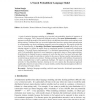456 search results - page 23 / 92 » Assessing the Significance of Sets of Words |
NIPS
2000
13 years 8 months ago
2000
A goal of statistical language modeling is to learn the joint probability function of sequences of words in a language. This is intrinsically difficult because of the curse of dim...
COLING
2008
13 years 9 months ago
2008
We present an automatic method for senselabeling of text in an unsupervised manner. The method makes use of distributionally similar words to derive an automatically labeled train...
INFORMATICALT
1998
13 years 7 months ago
1998
Principles of the framework called time series forecasting automation are presented. It is required in processing massive temporal data sets and creating completely user-oriented f...
GECCO
1999
Springer
13 years 11 months ago
1999
Springer
This paper explores the use of growth processes, or embryogenies, to map genotypes to phenotypes within evolutionary systems. Following a summary of the significant features of em...
CICLING
2009
Springer
14 years 8 months ago
2009
Springer
We cast name discrimination as a problem in clustering short contexts. Each occurrence of an ambiguous name is treated independently, and represented using second?order context vec...

